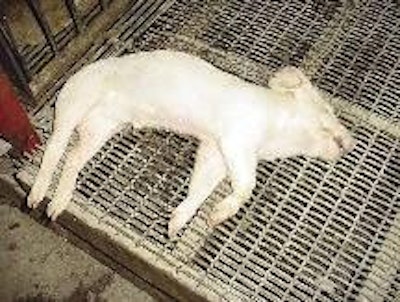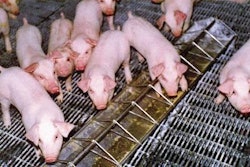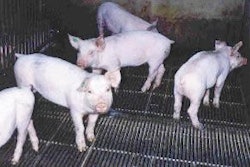
Have a hand-washing station readily available, wear gloves when handling sick and dead pigs, do not rub your fingers against your eyes, do not put equipment in your mouth. Those were the central recommendations from Dr Barbara Straw, holder of the Dave Ellis Swine Professorship at Michigan State University, USA, when addressing the 2006 Pork Academy about the risks of transferring infections by poor hygiene practices in piglet processing. She said that pig-unit workers too often break the rules such as by holding a vaccination syringe in their mouth while picking up the next pig for treatment. When they did this they could also pick up an infection of Strep. suis.
Dr Straw was making her remarks soon after the USA confirmed its first ever definite case of Streptococcus suis in a human patient. It involved a pig producer from New York state. In one sense this was rather typical, she commented, in that most known incidents around the world have been among people in contact with pig slaughter or pig carcases as part of their work. Some uncertainty also exists whether the data available worldwide give an accurate reflection of the frequency with which a crossover of infection occurs. Although other countries and regions have reported suspected episodes on an increasing basis, the medical literature shows a global total of only 150 confirmed cases in humans since 1960.
"Statistically, according to this data, we have more chance of being hit by lightning," she said. "Diagnosing S. suis is still rather difficult, however, especially in people who may have been taking antibiotics previously. You must also be looking for it before you find it and that means the recognition is greater in countries which have had a past history of the disease. So there may have been more cases that were not identified or reported. I doubt, however, whether it occurs more often now than in the past.
"What we do know is that the pig is the normal host of these streptococci and that many pigs carry the bacteria in their tonsils. But the fact that Strep. suis is everywhere around you does not imply that you will become sick. The bacteria can stay in the pigs' tonsils doing nothing and the pigs themselves look healthy. Surveys that have found antibodies to the bacteria in pig producers and veterinary students have also reported that none of these people were ill. Even so, we must be aware of the risk and guard against it, such as by applying good hygiene precautions."
According to Dr Straw, the name Streptococcus suis should be recognised as covering several different although related disease entities. At least 35 serotypes are known, affecting other species as well as pigs. However, all of them are transmitted in a similar manner and each represents a potential zoonosis in that it is capable of infecting both animals and humans. Its transmission can be through lacerations of the skin and by ingestion as well as by air-borne and insect-borne bacteria. Flies from a manure heap have been shown to carry the bacteria for over 3 kilometres.
Most infection of humans has been followed by symptoms including vomiting, diarrhoea, headaches and meningitis. Some 7% of the victims died. Around half of those who recovered were left with some degree of deafness, others have developed arthritis or vertigo. These incidents have most often involved workers in slaughterhouses, who probably became infected through a cut in their skin while handling a contaminated pig carcase. Antibodies to Strep. suis have been found in abattoir staff and in pig-unit personnel on numerous occasions.
Clinical signs of the infection in pigs typically occur in weaners that are stressed, Dr Straw observed. Once again meningitis and arthritis are among the findings. Onset can be acute and rapid, the pig looking fine one day and dying suddenly the day after. Whole groups are often affected at the same time, perhaps after being chilled.
"One case I was involved in went like clockwork. The pigs seemed to be healthy at weaning and one week later, but at 10 days in the nursery they started to look bad. It turned out that the nursery caretaker had moved the temperature control thermostat up to the ceiling out of his way. Returning it to near floor level where it belonged restored the right temperature for the pigs and eliminated the outbreak."
She cautioned that because Strep. suis can be systemic in the blood, reaching many points of the pig's body, it takes a considerable amount of treatment to resolve. Gram-positive antibiotics work quite quickly against it in the laboratory, but in the conditions of a pig herd, about 6 weeks of the treatment may be required. The long period necessary is one of the prime reasons for the fact that the majority of Strep. suis cases are under-treated. Moreover, although penicillin works in over 90% of cases, it needs to be injected twice daily to have the desired therapeutic effect. That can be the problem in practice, said Dr Straw, with people injecting only once so there is not enough drug in the pig.
"Treatment and sanitation are 2 key points regarding these streptococci," she declared. "As far as biosecurity is concerned, it seems strange to me that pig units require people to take a shower before they enter and yet there is a relative lack of emphasis on internal sanitation. I push the case for hand washing in the places where piglets are processed."

















